Yolanda Court has long been considered one of San Anselmo’s most charming neighborhoods with its wide, tree-lined streets and manicured properties of architectural interest.

Entrance to Yolanda Court, 1910, from subdivision brochure. Courtesy of Nate McKitterick.
The story of Yolanda Court begins with the influx of new residents to town after the 1906 earthquake and fire when the owners of large tracts of land in San Anselmo began to subdivide and offer lots for sale. In 1909, Ellen Murray sold 16.4 acres in San Anselmo to Walter R. Hoag, a San Francisco real estate developer, for a reported price of $40,000. Ellen was the daughter of Larkspur pioneers Maria and William Murray who had purchased the property in 1886.
Ellen Murray’s tract of land, known as Murray’s Meadows, was nestled between San Anselmo Creek on the north, the Northwestern Pacific Railroad track on the south (today’s Center Boulevard) and Saunders Avenue on the east. The Yolanda Court subdivision map was drawn in 1909 with 69 lots and then was redrawn in 1910 with 80 lots.
Two roads were laid out, Yolanda Drive and Laurel Avenue; Laurel was renamed Alder Avenue in 1922. W.R. Hoag & Co. advertised in the San Francisco Call and San Francisco Chronicle: “Yolanda Court, a high class, secluded residence tract just opened, the most famous and beautiful wooded field in Marin county; fine live oaks, alder and laurel trees. Right at Yolanda Station, on electric line. Large lots: sewer, water, electric lights and gas, macadamized roads, cement sidewalks, cement curbs.” Lot prices were originally $750 to $1,750.
Hoag made notable improvements in the subdivision, including roads sunken below the surface of the lots to ensure good drainage and utility poles placed at the rear of the lots so the streets were free of power poles. Light fixtures were installed on the entrance gate to Yolanda Court.
Lot sales were steady, and by the end of 1913, 60 of the 80 lots had been sold. However, by the time the 1919 Sanborn Map was drawn (see below) only 24 homes had been constructed. This may indicate that some lots were purchased as speculative investments rather than as immediate summer of permanent home sites. Nine more homes were built over the next five years, and by 1950, all but 10 lots had been built upon. Most of these homes remain today, though many have been remodeled and enlarged with second floor additions.
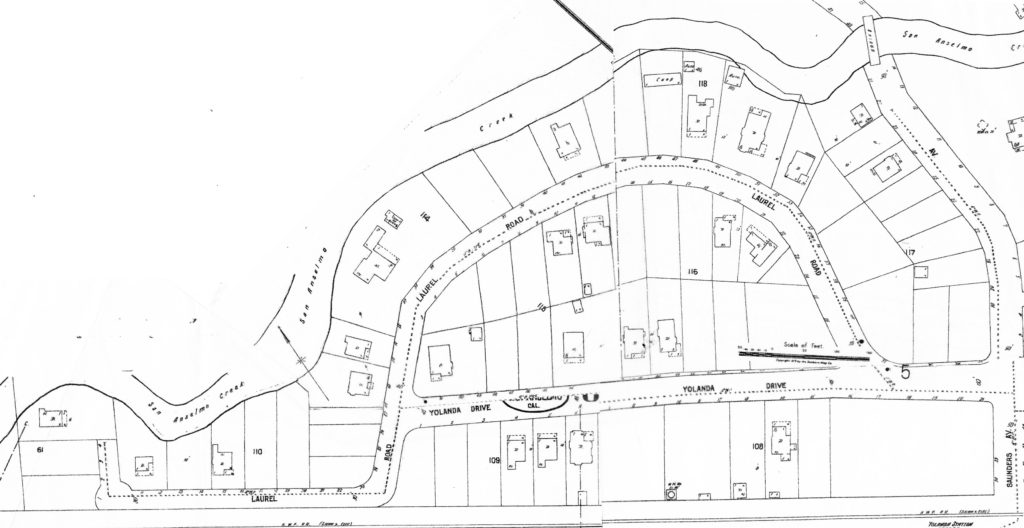
Most of the early homes were shingled Craftsman bungalows with a few stuccoed ones intermixed. Local contractors Robert Wallace and Hector Lanpher built several of the homes including ones for themselves, Wallace in 1911 at 50 Alder and Lanpher in 1914 at 57 Yolanda. A decade later, Robert Watson, another well-known San Anselmo contractor, built his Spanish Eclectic-style home at 15 Yolanda.
One of the first homes built was that of the Ephraim Shelton family at 64 Alder where the San Anselmo Herald reported “they conducted an extensive chicken ranch.” And sure enough, the Sanborn map shows a “coop” on the adjacent lot that the Sheltons also owned. The Sheltons did not stay long and sold to Etta and Frank J. Burns of San Francisco. It was a summer home for the Burns family. After Etta and Frank died in 1936, the property fell into a state of disrepair. Former Yolanda Court residents Kathleen Kaenel Devlin, Eleanor Zobel Holton and Bonnie Orendorff remember it as the “mystery house” or “haunted house” with curtains drawn and rambling blackberry bushes on the vacant lot. Orendorff wrote in a Facebook post that “the haunted house was just an old abandoned house on Alder. We just called it that because it was so overgrown, dark and scary looking! Inside was very old furniture, pipe stove. Like someone just died or left, and there it sat for many years, house and land.” The property was finally sold in 1976 after the last of the Burns children died.
Wallace and Lanpher built the home at 114 Alder Avenue in 1912 for Emma and John Totheroh. The Totherohs are enumerated there in the 1920 census with their son Dan who the following year wrote Tamalpa, the fictitious legend of the sleeping maiden, for the Mountain Theater. Dan Totheroh went on to a successful career as a playwright and later returned to the Mountain Theater as its director.
In 1913, Susie and Arthur Baker purchased the lot at 159 Alder and built a summer home. “The Bungalow,” as they called it, was used by family and friends for weekend or summer escapes from foggy San Francisco. The Baker’s daughter Elizabeth and her husband Charles C. Van Liew resided there after Arthur’s death in 1916.
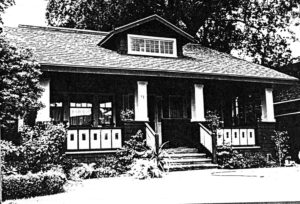
73 Alder Avenue, 1987
San Anselmo contractor William H. Dwyer built a summer bungalow for Emma and Emile A. Groezinger of San Francisco at 73 Alder; the contract price was $2150. The Groezinger’s lot at 69 Alder was an orchard.
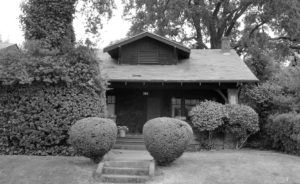
61 Yolanda Avenue, 1987
In 1915, San Rafael contractor Leslie Warden built identical one-story shingled homes for Irene and Lloyd Elgin at 61 Yolanda and Edith and Louis Glaudon at 63 Yolanda. Irene and Edith were sisters. Both couples were longtime Yolanda Court residents with the Glaudons eventually moving to a new home at 21 Yolanda. Lloyd Elgin raised and raced homing pigeons, and Louis Glaudon, an avid gardener, grew prize-winning camellias, azaleas and rhododendrons and frequently gave talks to local garden clubs.
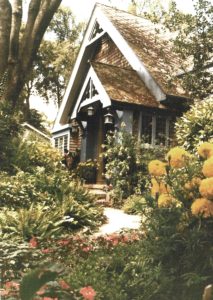
100 Alder Avenue, 1972. Courtesy Kathleen Devlin
The largest property owners were Ella May and George Breck, who between 1912 and 1917 purchased five lots, encompassing the homes today at 100, 106, and 110 Alder. Their home “The Igloo” was, and is today, noted for the 5-story water tank which towers over the neighborhood.
Many of the other original home owners have been identified through news articles and census records; the details will be available at the Historical Museum for future reference.
The early residents of Yolanda Court were part of an active improvement association. Regular meetings were held twice a month and weekly card and dance parties were held at the Yolansdale School. The association advocated for better roads and street lighting; residents chipped in and purchased street light fixtures designed by George Breck and had the town wire and electrify them. The Herald reported that the electric lights made “a swell appearance being very ornamental.”
A fund-raising event in 1923 for the Yolansdale Community Church was billed as “A Trip Around the World.” Homes in Yolanda Court, each representing a different country, were open and decorated. Groups moved from one “country” to another where they saw a Paris fashion show in France, sword dancers in kilts with bagpipe music in Scotland, and organ grinders in Italy. At the Breck “Igloo” home they saw a slide show of scenes of Alaska. Many other countries were represented, and 300 people attended the event.
Former residents have fond memories of growing up in Yolanda Court where children were free to roam and explore with few restrictions. Kathleen Devlin recalls the parental mantra, “Don’t leave the Court and come home before dark.”
Eleanor (Wink) Zobel Holton reminisced in her 2018 oral history interview about her activities in the creek behind her family’s home at 90 Alder: “I’d go down there and sit for hours just fishing, bringing up those little trout – which I didn’t like…it was very relaxing to me.” Holton also described crossing the creek to pick tomatoes for the Cordone family and being paid five cents a box.
The Wallace Myers family purchased 100 Alder in 1946 from the Breck estate. They put in a pool, and Holton described how the pool was shared with the neighbors. “When the flag was up, you could swim, and it was up most of the time. If they were having a party or having people over, why, then, of course they wanted it for themselves, which is understandable. But we were there all the time, and then Mary Landram, who lived next door to me on the other side at 82 Alder…we’d go every New Year’s Day, no matter what the weather. We’d go over and swim in that pool. Believe me, there were times when it was really cold, but that’s, you know, a fun thing to do when you’re young; you don’t think anything about it.”
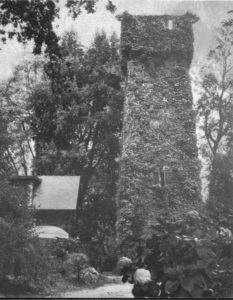
The water tower was completely covered by Virginia Creeper by the 1940s and quite dilapidated by the 1960s. The vine eventually died. The tower was dangerous but that didn’t stop the neighborhood children from exploring it.
And of course, former residents remember their escapades exploring the five-story water tower at 100 Alder that became quite dilapidated by the 1960s. Bonnie Orendorff again wrote in a Facebook post, “We were told to NEVER go up because it was really dangerous. It was! We did anyway and got to the top. Nice view. Could see Drake. As we climbed up the very rickety and partly collapsed stairs, we could enter little tiny rooms, with little sinks… further up the stairs had collapsed. Very hard coming down, big chunks of stairs were gone.”
While the residents have changed and homes have been updated or replaced, Yolanda Court remains what it has always been—an ideal place to grow up and a quiet, friendly neighborhood with vintage charm.
–Judy Coy

